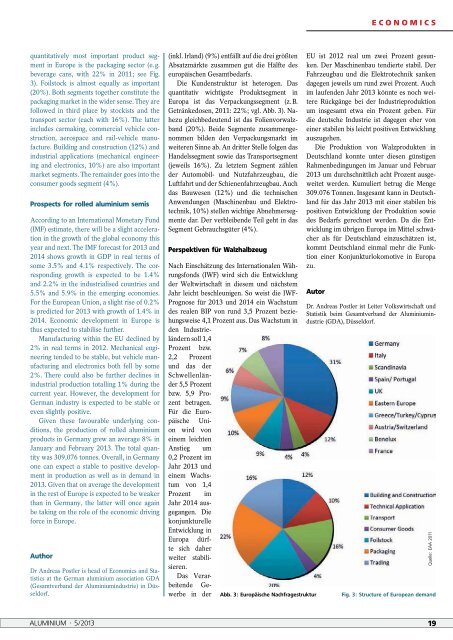SMS Siemag AG - Alu-web.de
SMS Siemag AG - Alu-web.de
SMS Siemag AG - Alu-web.de
You also want an ePaper? Increase the reach of your titles
YUMPU automatically turns print PDFs into web optimized ePapers that Google loves.
E conoM ics<br />
quantitatively most important product segment<br />
in Europe is the packaging sector (e. g.<br />
beverage cans, with 22% in 2011; see Fig.<br />
3). Foilstock is almost equally as important<br />
(20%). Both segments together constitute the<br />
packaging market in the wi<strong>de</strong>r sense. They are<br />
followed in third place by stockists and the<br />
transport sector (each with 16%). The latter<br />
inclu<strong>de</strong>s carmaking, commercial vehicle construction,<br />
aerospace and rail-vehicle manufacture.<br />
Building and construction (12%) and<br />
industrial applications (mechanical engineering<br />
and electronics, 10%) are also important<br />
market segments. The remain<strong>de</strong>r goes into the<br />
consumer goods segment (4%).<br />
Prospects for rolled aluminium semis<br />
According to an International Monetary Fund<br />
(IMF) estimate, there will be a slight acceleration<br />
in the growth of the global economy this<br />
year and next. The IMF forecast for 2013 and<br />
2014 shows growth in GDP in real terms of<br />
some 3.5% and 4.1% respectively. The corresponding<br />
growth is expected to be 1.4%<br />
and 2.2% in the industrialised countries and<br />
5.5% and 5.9% in the emerging economies.<br />
For the European Union, a slight rise of 0.2%<br />
is predicted for 2013 with growth of 1.4% in<br />
2014. Economic <strong>de</strong>velopment in Europe is<br />
thus expected to stabilise further.<br />
Manufacturing within the EU <strong>de</strong>clined by<br />
2% in real terms in 2012. Mechanical engineering<br />
ten<strong>de</strong>d to be stable, but vehicle manufacturing<br />
and electronics both fell by some<br />
2%. There could also be further <strong>de</strong>clines in<br />
industrial production totalling 1% during the<br />
current year. However, the <strong>de</strong>velopment for<br />
German industry is expected to be stable or<br />
even slightly positive.<br />
Given these favourable un<strong>de</strong>rlying conditions,<br />
the production of rolled aluminium<br />
products in Germany grew an average 8% in<br />
January and February 2013. The total quantity<br />
was 309,076 tonnes. Overall, in Germany<br />
one can expect a stable to positive <strong>de</strong>velopment<br />
in production as well as in <strong>de</strong>mand in<br />
2013. Given that on average the <strong>de</strong>velopment<br />
in the rest of Europe is expected to be weaker<br />
than in Germany, the latter will once again<br />
be taking on the role of the economic driving<br />
force in Europe.<br />
author<br />
Dr Andreas Postler is head of Economics and Statistics<br />
at the German aluminium association GDA<br />
(Gesamtverband <strong>de</strong>r <strong>Alu</strong>miniumindustrie) in Düsseldorf.<br />
(inkl. Irland) (9%) entfällt auf die drei größten<br />
Absatzmärkte zusammen gut die Hälfte <strong>de</strong>s<br />
europäischen Gesamtbedarfs.<br />
Die Kun<strong>de</strong>nstruktur ist heterogen. Das<br />
quantitativ wichtigste Produktsegment in<br />
Europa ist das Verpackungssegment (z. B.<br />
Getränkedosen, 2011: 22%; vgl. Abb. 3). Nahezu<br />
gleichbe<strong>de</strong>utend ist das Folienvorwalzband<br />
(20%). Bei<strong>de</strong> Segmente zusammengenommen<br />
bil<strong>de</strong>n <strong>de</strong>n Verpackungsmarkt im<br />
weiteren Sinne ab. An dritter Stelle folgen das<br />
Han<strong>de</strong>lssegment sowie das Transportsegment<br />
(jeweils 16%). Zu letztem Segment zählen<br />
<strong>de</strong>r Automobil- und Nutzfahrzeugbau, die<br />
Luftfahrt und <strong>de</strong>r Schienenfahrzeugbau. Auch<br />
das Bauwesen (12%) und die technischen<br />
Anwendungen (Maschinenbau und Elektrotechnik,<br />
10%) stellen wichtige Abnehmersegmente<br />
dar. Der verbleiben<strong>de</strong> Teil geht in das<br />
Segment Gebrauchsgüter (4%).<br />
Perspektiven für Walzhalbzeug<br />
Nach Einschätzung <strong>de</strong>s Internationalen Währungsfonds<br />
(IWF) wird sich die Entwicklung<br />
<strong>de</strong>r Weltwirtschaft in diesem und nächstem<br />
Jahr leicht beschleunigen. So weist die IWF-<br />
Prognose für 2013 und 2014 ein Wachstum<br />
<strong>de</strong>s realen BIP von rund 3,5 Prozent beziehungsweise<br />
4,1 Prozent aus. Das Wachstum in<br />
<strong>de</strong>n Industrielän<strong>de</strong>rn<br />
soll 1,4<br />
Prozent bzw.<br />
2,2 Prozent<br />
und das <strong>de</strong>r<br />
Schwellenlän<strong>de</strong>r<br />
5,5 Prozent<br />
bzw. 5,9 Prozent<br />
betragen.<br />
Für die Europäische<br />
Union<br />
wird von<br />
einem leichten<br />
Anstieg um<br />
0,2 Prozent im<br />
Jahr 2013 und<br />
einem Wachstum<br />
von 1,4<br />
Prozent im<br />
Jahr 2014 ausgegangen.<br />
Die<br />
konjunkturelle<br />
Entwicklung in<br />
Europa dürfte<br />
sich daher<br />
weiter stabilisieren.<br />
Das Verarbeiten<strong>de</strong><br />
Gewerbe<br />
in <strong>de</strong>r<br />
EU ist 2012 real um zwei Prozent gesunken.<br />
Der Maschinenbau tendierte stabil. Der<br />
Fahrzeugbau und die Elektrotechnik sanken<br />
dagegen jeweils um rund zwei Prozent. Auch<br />
im laufen<strong>de</strong>n Jahr 2013 könnte es noch weitere<br />
Rückgänge bei <strong>de</strong>r Industrieproduktion<br />
um insgesamt etwa ein Prozent geben. Für<br />
die <strong>de</strong>utsche Industrie ist dagegen eher von<br />
einer stabilen bis leicht positiven Entwicklung<br />
auszugehen.<br />
Die Produktion von Walzprodukten in<br />
Deutschland konnte unter diesen günstigen<br />
Rahmenbedingungen im Januar und Februar<br />
2013 um durchschnittlich acht Prozent ausgeweitet<br />
wer<strong>de</strong>n. Kumuliert betrug die Menge<br />
309.076 Tonnen. Insgesamt kann in Deutschland<br />
für das Jahr 2013 mit einer stabilen bis<br />
positiven Entwicklung <strong>de</strong>r Produktion sowie<br />
<strong>de</strong>s Bedarfs gerechnet wer<strong>de</strong>n. Da die Entwicklung<br />
im übrigen Europa im Mittel schwächer<br />
als für Deutschland einzuschätzen ist,<br />
kommt Deutschland einmal mehr die Funktion<br />
einer Konjunkturlokomotive in Europa<br />
zu.<br />
autor<br />
Abb. 3: Europäische Nachfragestruktur<br />
Dr. Andreas Postler ist Leiter Volkswirtschaft und<br />
Statistik beim Gesamtverband <strong>de</strong>r <strong>Alu</strong>miniumindustrie<br />
(GDA), Düsseldorf.<br />
Quelle: EAA 2011<br />
Fig. 3: Structure of European <strong>de</strong>mand<br />
ALUMINIUM · 5/2013 19
















